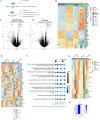Genome-wide CRISPR Screen Identifies Sec31A as a Key Regulator of Alpha Cell Survival
- PMID: 41093834
- PMCID: PMC12528718
- DOI: 10.1038/s41467-025-64169-5
Genome-wide CRISPR Screen Identifies Sec31A as a Key Regulator of Alpha Cell Survival
Abstract
Glucagon, secreted by pancreatic alpha cells, is essential for maintaining normal blood glucose levels. In type 1 and advanced type 2 diabetes, alpha cells often fail to respond to low glucose, yet the mechanisms underlying their stress resistance remain unclear. To investigate this, we performed a genome-wide CRISPR screen and identify Sec31A, a gene involved in transporting proteins from the endoplasmic reticulum (ER), as a key regulator of alpha cell survival under stress. We show that loss of Sec31A enhances survival in stressed mouse alpha cells and in C. elegans. In human islets, SEC31A expression increases in alpha cells under inflammatory stress, and this upregulation is reversed by reducing ER stress. Functional studies in lab-grown human islet clusters reveal distinct responses in alpha versus beta cells following Sec31A suppression. We also find that Sec31A interacts with the insulin receptor, suggesting a link between stress adaptation and insulin signaling in alpha cells.
© 2025. The Author(s).
Conflict of interest statement
Competing interests: R.N.K. serves on the Scientific Advisory Boards of Novo Nordisk, Biomea and REDD Pharmaceuticals. The other authors declare no competing interests.
Figures







References
-
- Hædersdal, S., Andersen, A., Knop, F. K. & Vilsbøll, T. Revisiting the role of glucagon in health, diabetes mellitus and other metabolic diseases. Nat. Rev. Endocrinol. 19, 321–335 (2023). - PubMed
MeSH terms
Substances
Grants and funding
- DK067536/U.S. Department of Health & Human Services | National Institutes of Health (NIH)
- R35GM122610/U.S. Department of Health & Human Services | National Institutes of Health (NIH)
- R01AG054215/U.S. Department of Health & Human Services | National Institutes of Health (NIH)
- JP22K16404/MEXT | Japan Society for the Promotion of Science (JSPS)
LinkOut - more resources
Full Text Sources
Miscellaneous

